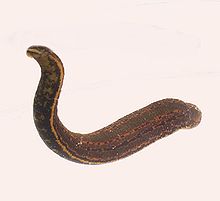Question time! What are the similarities between these two pictures? Take your time and look at them.
 |
| A leech Image from abhirambharat.webs.com |
Still no clue? Alright! Let me tell you.
First, I think most of you have used Hirudoid, the cream in the first picture, when you have an ugly bruise on your nice legs or arms (hope not on your face, you might want to call the police if you do), but have you ever wondered what bruises are?
 |
| A bruise Image from Wikipedia |
In simple words, a bruise is a slight bleeding outside the blood vessels but inside your skin, forming a packet of blood called a "hematoma" [2]
When that happens, smart people usually grab a tube of Hirudoid and apply on the affected area to speed up the recovery. But what is in the Hirudoid and how does it work?
Hirudoid actually contains an active ingredient called Mucopolysaccharide polysulfate [3] or more commonly known as heparinoid [4][5][6][7] which is derived from heparin [7], a strong anticoagulant which prevents blood from clotting or coagulating.
When you apply Hirudoid, the cream is absorbed into the skin, the blood doesn't clot, and the black and blue will then disappear.
So far, can you follow?
 |
| hirudo medicinalis Image from Wikipedia |
 |
| Ancient Greek painting in a vase, showing a physician (iatros) bleeding a patient Image from Wikipedia |
So, you now understand how Hirudoid and Leeches are similar? And you know why Hirudoid is called Hirudoid?
Something extra for you ladies! See below:
Vocabulary:
subtle -- (adj) approving small but important
Hirudoid
bruise -- (n) [C] also called a contusion, is a type of relatively minor hematoma of tissue[1] in which capillaries and sometimes venules are damaged by trauma, allowing blood to seep into the surrounding interstitial tissues.
hematoma -- (n)[C] is an extravasation of blood outside the blood vessels, generally the result ofhemorrhage. A hematoma is a pocket or localized collection of blood usually in liquid form within the tissue.
heparinoid -- (n)[U] are glycosaminoglycans which are derivatives of heparin.
heparin -- (n)[U] also known as unfractionated heparin, a highly-sulfatedglycosaminoglycan, is widely used as an injectable anticoagulant
anticoagulant -- (n)[C] a substance that prevents coagulation; that is, it stops blood from clotting.
clot -- (vb)[I] forming an almost solid piece of something
coagulate -- (vb)[I or T] to change from liquid to a more solid state, or to cause something to do this
black and blue -- with dark marks on your skin caused by being hit or having an accident
bloodletting -- (c)[U] is the withdrawal of often considerable quantities of blood from a patient to cure or prevent illness and disease.
hirudotherapy -- (n)[C] In medieval and early modern medicine, the medicinal leech (Hirudo medicinalis and its congeners Hirudo verbana, Hirudo troctina and Hirudo orientalis) was used to remove blood from a patient as part of a process to "balance" the "humors" that, according to Galen, must be kept in balance in order for the human body to function properly.
microsurgery -- (n) [U] is a general term for surgery requiring an operating microscope.
Resources:
Hirudin @ Wikipedia
http://en.wikipedia.org/wiki/Hirudin
Bruise @ Wikipedia
[1] http://en.wikipedia.org/wiki/Bruise
Hematoma @ Wikipedia
[2] http://en.wikipedia.org/wiki/Hematoma
Safety Data Sheet HIRUDOID CREAM / HIRUDOID SALBE
[3] http://www.briggatemedical.com/pdfs/msds_hirudoid.pdf
Hirudoid Cream @ netdoctor
[4] http://www.netdoctor.co.uk/medicines/100001249.html
Glycosaminoglycan @ Wikipedia
[5] http://en.wikipedia.org/wiki/Glycosaminoglycan
Heparinoid @ Wikipedia
[6] http://en.wikipedia.org/wiki/Heparinoid
Heparin @ Wikipedia
[7] http://en.wikipedia.org/wiki/Heparin
Anticoagulant @ Wikipedia
http://en.wikipedia.org/wiki/Anticoagulant
Leech @ Wikipedia
[8] http://en.wikipedia.org/wiki/Leech
Hirudo medicinalis @ Wikipedia
http://en.wikipedia.org/wiki/Hirudo_medicinalis
Hirudin @ Wikipedia
[9] http://en.wikipedia.org/wiki/Hirudin
Hirudotherapy @ Wikipedia
Microsurgery @ Wikipedia

